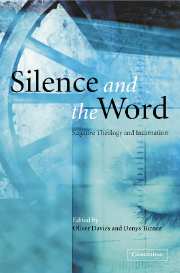Book contents
- Frontmatter
- Contents
- Notes on contributors
- Preface
- Introduction
- 1 Apophaticism, idolatry and the claims of reason
- 2 The quest for a place which is ‘not-a-place’: the hiddenness of God and the presence of God
- 3 The gift of the Name: Moses and the burning bush
- 4 Aquinas on the Trinity
- 5 Vere tu es Deus absconditus: the hidden God in Luther and some mystics
- 6 The deflections of desire: negative theology in trinitarian disclosure
- 7 The formation of mind: Trinity and understanding in Newman
- 8 ‘In the daylight forever?’: language and silence
- 9 Apophasis and the Shoah: where was Jesus Christ at Auschwitz?
- 10 Soundings: towards a theological poetics of silence
- Select bibliography
- Index
5 - Vere tu es Deus absconditus: the hidden God in Luther and some mystics
Published online by Cambridge University Press: 22 September 2009
- Frontmatter
- Contents
- Notes on contributors
- Preface
- Introduction
- 1 Apophaticism, idolatry and the claims of reason
- 2 The quest for a place which is ‘not-a-place’: the hiddenness of God and the presence of God
- 3 The gift of the Name: Moses and the burning bush
- 4 Aquinas on the Trinity
- 5 Vere tu es Deus absconditus: the hidden God in Luther and some mystics
- 6 The deflections of desire: negative theology in trinitarian disclosure
- 7 The formation of mind: Trinity and understanding in Newman
- 8 ‘In the daylight forever?’: language and silence
- 9 Apophasis and the Shoah: where was Jesus Christ at Auschwitz?
- 10 Soundings: towards a theological poetics of silence
- Select bibliography
- Index
Summary
Vere tu es Deus absconditus – ‘Truly, you are a God who hidest thyself.’ In commenting on this verse from Isaiah 45:15 in his exegesis of the book, Martin Luther drew a parallel between the prophet's time and his own. The divine promise of restoration to Jerusalem, despite the trials of Isaiah's era, led the seer to exclaim that God's ways were beyond the power of reason, ‘The flesh sees nothing and concludes: Nothing produces nothing.’ But the eyes of faith see differently. ‘So today’, Luther continues, ‘we see in the Word the progress of the Church of God against the force and schemes of all tyrants. Since faith is the conviction of things not seen, the opposite must appear to be the case.’
Throughout his later Lectures on Genesis (1535–45) the reformer often employs the theme of divine hiddenness, citing the Isaian text in four of these discussions. In order to grasp the meaning of these and other passages, it is useful to note that Luther seems to have distinguished between two forms of God's hiddenness: God's hiding of himself sub contrariis, that is, under contrary signs; and God's hiding of himself in the dark mystery of predestination.
The first hiddenness, cloaking sub contrariis, shows how the tribulations endured by the patriarchs, so often in conflict with the promises God had made to them, provide the model for us, their heirs in belief.
- Type
- Chapter
- Information
- Silence and the WordNegative Theology and Incarnation, pp. 94 - 114Publisher: Cambridge University PressPrint publication year: 2002
- 2
- Cited by

